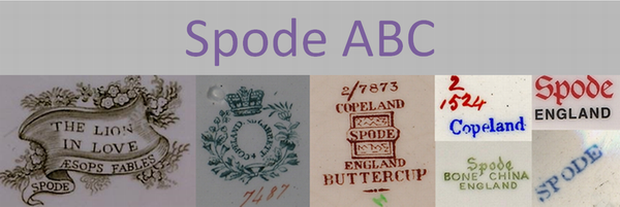This refers to a style of large cup - see Joke Cup on the J page.
Mansard
Mansard is the name of a shape which was introduced in 1932. It was registered with the British Patent Office in that year with number 777266. A patent was also registered in the United States with number 88688. The shape was originally produced in fine earthenware on Spode (ivory) body.
The border of the shape is moulded and works very effectively. The first pattern which was successful was Elaine with pattern number O1290, introduced in 1936, in which the embossed laurel bead below the verge was printed in Cerulean blue.
Mansard Imperial, a plain ivory earthenware, remained popular for many years but was eventually discontinued in 1963.
 |
| Elaine pattern on Mansard shape, 1957 |
Cherry Picker with pattern number S1959 introduced in 1937
Lady Anne with pattern number S2618 introduced in 1947
Hunting Centres with pattern number S2765 introduced in 1954
Continental Scenes with pattern number S3111 introduced in 1955
Antoine with pattern number S3318 introduced in 1959
Fortnum & Mason Centres with pattern number S1990, introduced in 1937, was produced as dessert ware but with 10" dinner plates, with 12 different botanical subjects. Pansy, Primula, Begonia, Camellia, Tulip, Aster, Single Dahlia, Dahlia, Anemone, Geranium, Ranunculus, Mallows
In about 1993 Mansard was re-introduced but this time in fine bone china. At first this was as white only which is lovely and my own choice of dinner service. Spode's bone china was always particularly white giving an extremely elegant look to a table when set for dinner.
Later a number of patterns were introduced including:
Mansard Gold with pattern number Y8602 which was plain Mansard bone china decorated with a gold edge, introduced in 1996.
Mansard Platinum with pattern number Y8611 which was plain Mansard bone china decorated with a platinum edge, introduced in 1998.
Virginia with pattern number Y8601 was introduced in 1996. This used elegant centres of white flower designs which were inspired by Spode’s pattern numbers 1875, 1923 and 1924 of 1813. This antique pattern 1875 was originally produced on Dolphin Embossed shape as illustrated or for pattern numbers 1923 and 1924 on Swag Embossed shape and featured hand painted white lilies from Madonna lily to water lily.
 |
| Pattern 1875 on Dolphin Embossed shape c1813 |
The names Marble and Mosaic have also been used for the pattern called Cracked Ice and Prunus. They are thought to refer to the use of the background Cracked Ice without the prunus blossom.
A version of Tumbledown Dick pattern uses Marble or Mosaic as the background to the bird and foliage design and a variant of Willis pattern has it as the rim border decoration. Shima is a modern version of Willis. You can find out about sheet patterns on the S page.
Another Marble is the name given to a printed design which imitates marble such as for toilet wares.
 |
| Toilet ware, basin, printed to look like marble, Copeland & Garrett, 1833-1847 |
Margrave
Margrave pattern was produced on Royal College shape. See my P-R page for more information on this elegant shape of the modern era.
Marketing
One of the reason for the great and long success of the Spode company (under different ownerships and at different times) was the skill in marketing. Click Spode and Marketing for more...
Also visit Spode Exhibition Online for more of Spode marketing in the the early 1800s. And Spode and the Movies.
Marketing
One of the reason for the great and long success of the Spode company (under different ownerships and at different times) was the skill in marketing. Click Spode and Marketing for more...
Also visit Spode Exhibition Online for more of Spode marketing in the the early 1800s. And Spode and the Movies.
Matchpot
 |
| Beaker shape matchpot, engine turned, red slip over creamware then green glazed c1800 |
 |
| Matchpot, bone china, pattern 711, c1805 |
 |
| Beaker shape matchpot, bone china, pattern 1166, c1808 |
Meadowsweet
Click HERE>
Michael Cardew
See Cardew on the C page
Missing Pattern Numbers
Click HERE> for mention of Spode's 'missing' pattern numbers.
 |
| Teapot stand in Spode's 'missing' pattern 522 c1804. Click HERE |
Mosaic
The names Mosaic and Marble
have also been used for
the pattern called Cracked Ice and Prunus. They are thought to refer to the use of the background Cracked Ice without the prunus blossom.
A version of Tumbledown Dick pattern
uses Marble or Mosaic as the background to the bird and foliage design and a
variant of Willis pattern has it as
the rim border decoration. Shima is a modern version of Willis. You can find out about sheet patterns on the S page.

